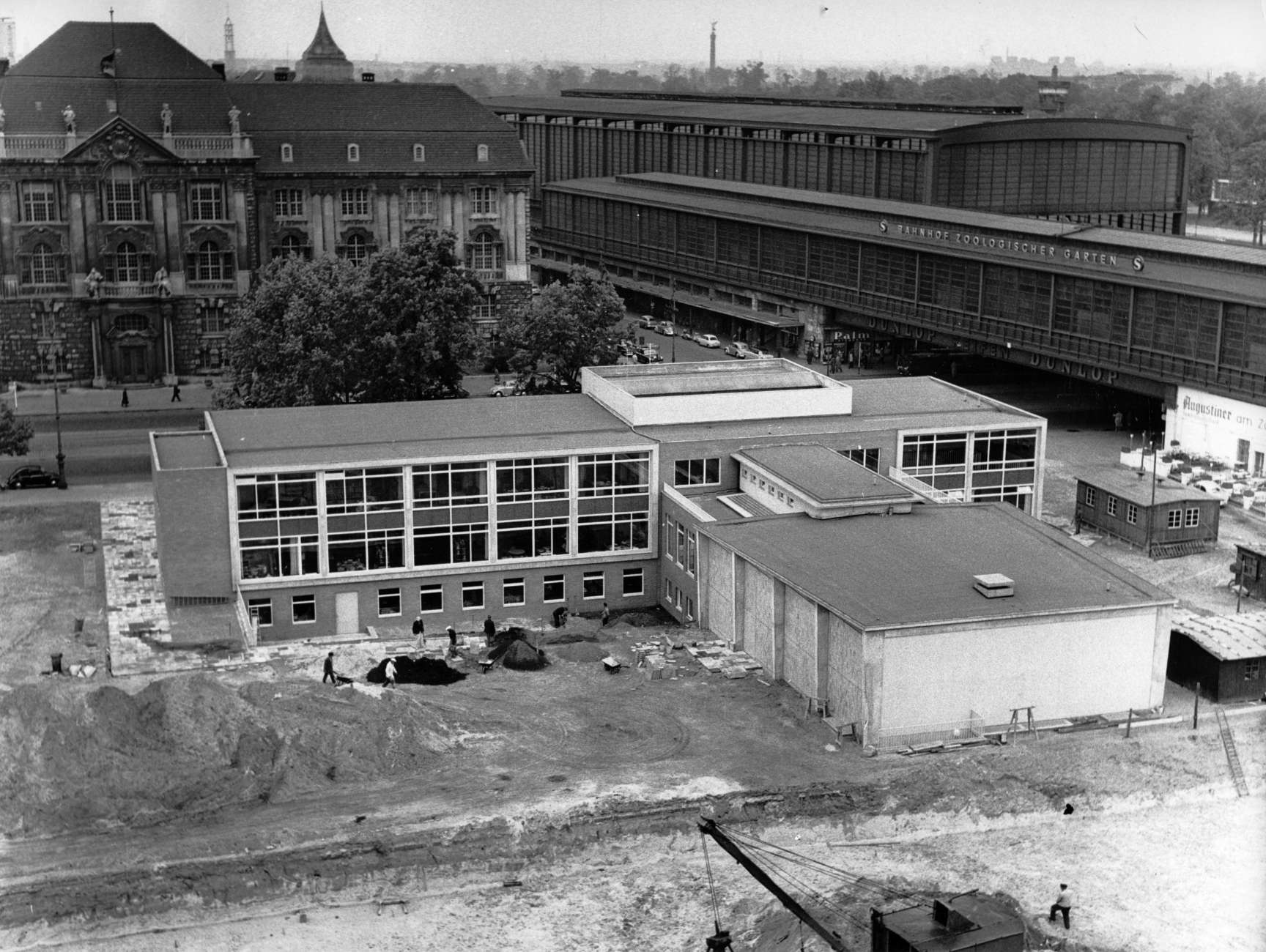Tracing: Amerika Haus (1957) (English)
It provides free, much-needed education – and at the same time is political propaganda. The construction history of Berlin’s Amerika Haus remains similarly contradictory: Initial plans for the post-war modernist building, hoping to be a symbol of a democratic new beginning, were submitted by the US-american firm SOM. Yet, the building was ultimately planned by Berlin’s then Senate Building Director, Bruno Grimmek, who had designed administrative buildings for the Nazi capital Berlin under Albert Speer a few years earlier. Here, as in so many other places and institutions in the Federal Republic of West Germany, the »democratic new beginning« was planned and implemented by established experts from the Nazi era.
Instead of the brutal, stone-faced monumentality of Nazi architecture, now glass and the colour white dominate. The »democratic utopia« presents itself with a generous glass facade on the ground floor, which is intended to convey openness and transparency – and at the same time serves as a shop window into the inner workings of the building, thus functioning as a propaganda tool: Look, here, in the »western democracy« you can read, talk, go to the cinema, attend events – in short: educate yourself and exchange ideas.
The open-shelf library on the ground floor was a novelty in Germany at the time (cf. Schöttler 2010, 324), and in its early days the windows could be fully opened on the street side, also expressing the US administration’s trust in library visitors (cf. Schöttler 2010, 325). Since the division of the city, visitors have come in large numbers, and not only from the western sector of the city: about a third traveled from the eastern sector (1960: 1,800,000 visitors, 700,000 of whom came from the eastern sector; cf. Hooper 2014, 281). Behind the large, transparent and openly designed library on the ground floor was the so-called »Ostbibliothek« [East Library]. Here, visitors from East Berlin could read and study, protected from view, »at least from the street, and thus out of reach from any informers« (Schöttler 2010, 320, translated from German). This service was in high demand until the city was divided – and the Americans’ strategy worked. After 1953, the occupying power no longer assumed that West Berliners needed to be convinced of US-style democracy: the aim was to establish contact with the population of East Berlin and the Soviet zone (cf. Hooper 2014, 276). The propaganda purpose in times of the Cold War was openly communicated in the USA, as the Denver Post wrote in 1960: this »modern, big-windowed building is probably the world's best located propaganda centre« (cited from Hooper 2014, 281). The large building cube cantilevered over the entrance makes this unmistakably clear: it is adorned with a striking mosaic – a stylised version of the US-american flag. Together with the unmissable, backlit lettering »AMERIKA HAUS« and the flag hoisted on the flagpole, the USA is impossible to ignore.
However, the democratic utopia, the building’s promise, cannot withstand the conflict long-term. The protests of the late 1960s against US foreign policy, the war, the armed »intervention« in Vietnam, also erupt at the Amerika Haus as a »symbolic representation« (Hiller von Gaertringen 2015, 199, translated from German) of the USA. The building, which was initially open to the public, is now guarded by security (cf. Hiller von Gaertringen/Proll 2015, 123), and a second layer of safety glass was added to the filigree window frames in 1973 (cf. Schöttler 2010, 329). The openness of the ground floor belongs to the past. This seems to be the beginning of the end of the »soft power« utopia of the Berlin Amerika Haus. After the fall of the Berlin Wall and the end of the Cold War, former users from East Berlin return the books they borrowed in 1961 – a symbolic act of gratitude and a marker that shows that the US-american cultural and educational institution has become obsolete. Instead, the principle of isolation is becoming the new architectural leitmotif: the windows and exterior doors are »fitted with security roller shutters installed on the inside, which is a further and, both functionally and visually, drastic step on the road to reversing the principles of the building's construction. Openness is no longer being dared; rather, anxious isolation is the order of the day.« (Schöttler 2010, 329, translated from German). Instead of openly inviting everyone, a fence is erected, also to distinguish the area from the Bahnhof Zoo drug hotspot.
The institution seems to have fallen out of time and space. – What still bears witness to these traces today?
Text by Hannah Strothmann
Bibliographie:
Schöttler, Sonja (2010): »Das AMERIKA HAUS in Berlin«, in: Ulrich Stevens/Ulrike Heckner (Hrsg.): DENKMAL-KULTUR IM RHEINLAND, Worms: Wernersche Verlagsgesellschaft mbH, S. 317–333.
Hooper, Kathleen R. (2014): Designing Democracy: Re-education and the America Houses (1945-1961): The American Information Centers and their Involvement in Democratic Re-education in Western Germany and West Berlin from 1945 to 1961, Frankfurt am Main: Peter Lang.
Hiller von Gaertringen, Hans Georg (2015): Pop, Politik und Propaganda: Das Amerika Haus Berlin im Wandel der Zeit, Ostfildern: Hatje Cantz Verlag.
Hiller von Gaertringen, Hans Georg/Proll, Astrid (2015): »Die amerikanische Prägung der 68er, die Studentenproteste und ein Brandsatz im Amerika Haus«, in: Hiller von Gaertringen,Hans Georg: Pop, Politik und Propaganda: Das Amerika Haus Berlin im Wandel der Zeit, Ostfildern: Hatje Cantz Verlag, S. 123–130.



